We can't afford to forget the north
Posted on
A house in the Tłı̨chǫ region. (Photo: Sandeep Agrawal)
Future Energy Systems researchers are demonstrating how energy systems are connected to social issues and homelessness in northern Indigenous communities
Tackling the social issues of the north takes money –– and energy. This is the central understanding that guided Abhimanyu Jamwal’s Master’s research project on the cost of energy in the Canadian north, under the supervision of Future Energy Systems Principal Investigator Sandeep Agrawal, a Professor in the University of Alberta’s Faculty of Science.
“Energy in the north costs much more than in other parts of Canada,” Abhimanyu explains. “I wanted to find out why.”
His investigation into the costs of northern energy –– and their social impacts –– emerged from Sandeep’s long-held interest in the social and economic issues that contribute to and affect homelessness, as well as a strong working relationship with the people of the Tłı̨chǫ region of Northwest Territories.
What Abhimanyu has learned over the course of his research, and the theme Sandeep continues to investigate, is that planning and implementing a just and fair future energy system in Canada’s north will require innovation and attention not just to the physical technologies employed, but also to the societal and human impacts they will have.
Injustice in housing
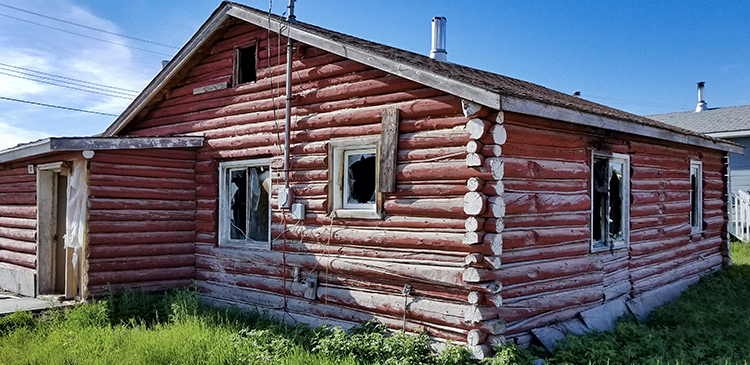
A house in the Tłı̨chǫ region. (Photo: Sandeep Agrawal)
For much of his professional life, Sandeep has studied human rights issues through a lens of urban and regional planning, with the specific aim of addressing problems of homelessness. This work has taken him around the world to examine the unique injustices found in places like the United Arab Emirates and Bangladesh. The most recent book he co-authored for Oxford University Press explores these questions in the context of his home country of India.
Since coming to the University of Alberta to serve as the inaugural director of the University’s School of Urban and Regional Planning, Sandeep has turned that global expertise to Canada’s north, and he is particularly focused on ensuring that Canada’s unique Indigenous issues are reflected and respected in any investigation of homelessness and human rights. His interest began in 2017, when he was visiting the Northwest Territories (NWT) to pursue potential internships for the school’s students.
“In Yellowknife, I was speaking to government officials and I mentioned how human rights issues often intersect with homelessness and housing issues,” he explains. “In talking about that with them, I was offered a project contract to find out the root causes of homelessness and look for policy solutions.”
So Sandeep began to go to communities and started his work, talking to people. He quickly discovered that a substantial number –– between 10 to 15 percent of Indigenous people living in the north, especially in certain communities –– may be homeless.
“There are no emergency shelters,” he says. “People are out in the streets, all year round.”
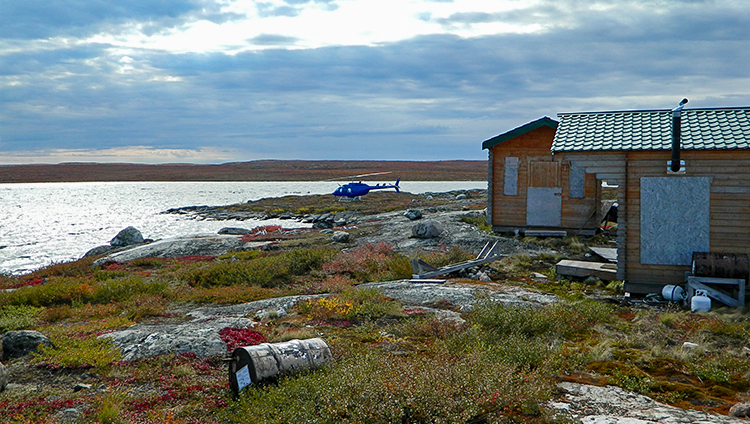
Reaching remote areas in the far north can necessitate air travel, including helicopters. (Photo: Valerie Miller)
Many communities in the north are fly-in/fly-out –– inaccessible by roads –– and the majority of their populations are Indigenous. Both these factors have major impacts on the homelessness situation. For example, Abhimanyu’s research reports that the NWT unemployment rate is the third highest in Canada. Critically, the unemployment rate among Indigenous people is much higher than non-Indigenous residents of NWT. For instance, Sandeep found that in 2016 the unemployment rate in the Tłı̨chǫ region was 21 percent, almost double that of the NWT at 10.6 percent. That gap has been increasing over the years.
Those sobering data remind Abhimanyu of his first experiences traveling to Canada’s north: “It’s very different from India, where I come from. I couldn’t believe how people live, so isolated, so far from each other, and how little opportunity there can be for people to earn a living.”
Like Sandeep, Abhimanyu’s road to this research began half a world away in India, where he completed a Masters in Geography. In his hometown, urban planning was not a known profession, but once he was introduced to the concept in university, he knew he’d found his calling. He came to the University of Alberta to complete his Masters in Urban and Regional Planning under Sandeep’s supervision, and now hopes to use that training to help address social injustices in the north.
But being able to make a difference is not just about expertise: Sandeep’s global experience in human rights and homelessness research has led him to emphasize the importance of understanding each situation as unique, and to ensure that any efforts to help are done appropriately. In the Canadian context, this led him to a simple realization.
“When I first got involved, I was looking at a human rights issue,” he says. “But I realized I had a flawed perspective. We need to look at it through an Indigenous rights lens.”
Northern issues
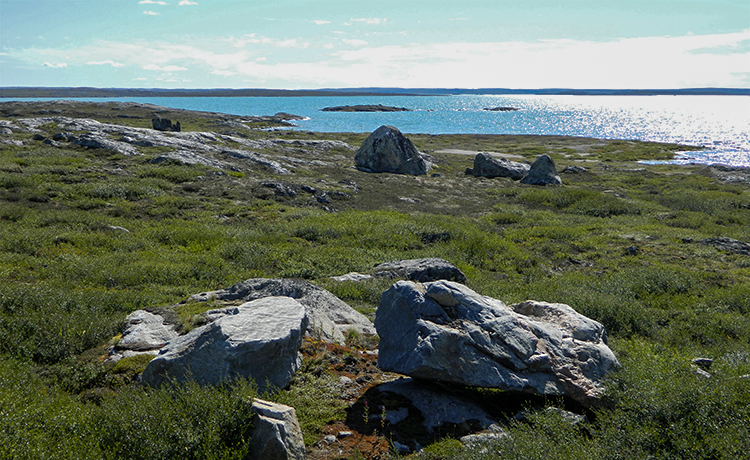
The unique climate, ecosystems, and social systems of the north are all factors important to consider in conducting far north research. (Photo: Valerie Miller)
When he started his work in the NWT, Sandeep quickly found a connection worth exploring: “I wanted to look at the nexus of energy and social issues.”
That included examining how the cost of energy affects or leads to social issues like homelessness, and how that homelessness can itself contribute to other social issues, including joblessness and poverty. Abhimanyu joined Sandeep’s group in 2018 to investigate those questions, but soon found a gap in the academic literature about the Canadian north, and Indigenous issues.
“There was a lot of information in the public domain, but not in academic journals,” he explains. “Things were missing –– information on homelessness, challenges with public housing and low income.”
In the absence of an existing scholarship, he needed to collect the relevant information for himself. To accomplish this, Sandeep prescribed the same approach he had used when working with impoverished communities in the United Arab Emirates, Bangladesh and elsewhere: directly engaging with a variety of local sources.
“This sort of community-based research must be hands-on, with the permission, support, and close involvement of the people who are facing these challenges every day,” he explains.
Abhimanyu thus got in contact with representatives from a few critical organizations: the Arctic Energy Alliance, Northwest Territories Housing Corporation, and Northwest Territories Government, Energy Division. The resulting conversations brought some alarming facts to light.
Income disparity within Indigenous communities can be significant. Despite the high unemployment rates, according to Statistics Canada the NWT holds the highest median income in Canada, in part because those who find employment in the natural resources sector enjoy very high salaries.
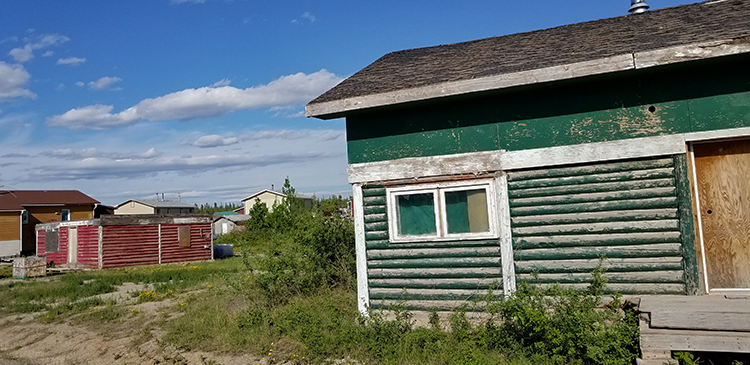
Homes in the far north, including in the Tłı̨chǫ region Sandeep is working with, face more wear and tear than homes in the north, further contributing to the housing crisis. (Photo: Sandeep Agrawal)
Most Indigenous families in the NWT, however, are not so fortunate. Sandeep’s ongoing relationship with the Tłı̨chǫ Government afforded him insight into the real and personal situations that many of these families and their communities face. For instance, families living in public housing –– often in multi-generation households –– receive social assistance of approximately $45,000 per year. As well as food and other necessities, that budget has to cover energy costs.
“The problem is the price. The average cost of electricity for a resident in NWT is about $4,600 a year,” Abhimanyu explains. That comes out to 8.2 percent of the annual Metis household income towards electricity, and 18 percent for an average Inuit household. “In Alberta, we pay on average 90 percent less per kilowatt-hour, compared to a resident in the NWT.”
If families default on paying their bills, the housing corporation has to evict them from their public housing, and families have to re-apply for public housing support from scratch –– often homeless in the meantime.
Families living in private housing face issues too. The average income for an average Inuit household in the territory is just $25,000, making a $4,600 annual energy bill difficult to manage while also covering the necessities of life. And if bills aren’t paid, electricity is cut off by the NWT energy corporation.
Since keeping warm at that latitude can mean life or death, non-electric ways for heating homes can be attempted, but those can lead to tragedy.
“Sometimes people have to resort to burning wood in improvised fireplaces. It’s not a safe choice, a lot of houses burn down. People end up homeless,” Abhimanyu says.
This is just one of the many issues that feeds into and intersects with the problem of homelessness in the north. Sandeep and Abhimanyu hope that by better understanding the energy influence on homelessness, they could start identifying solutions to address the problem.
As a first step, Abhimanyu knew he needed to figure out why energy costs were so high to begin with.
The cost of energy

A landscape in the Tłı̨chǫ region of NWT. (Photo: Sandeep Agrawal)
At first, it might seem that an obvious solution to the energy pricing crisis would be to simply produce more energy close to the communities that need it. Unfortunately, it’s not that easy. To begin with, most major energy installations would require the introduction of significant new infrastructure.
Like all construction in the north, infrastructure is very expensive to provide, and since these remote communities typically have populations numbering well under 500 people, the costs couldn’t be paid back by taxes or productivity. But even if more funds were available, the vastness of Canada’s remote north introduces more challenges.
“Building anything in these isolated communities is hard. You sometimes have to rely on ice roads, so you can only transport things in winter,” Abhimanyu explains. “It’s an exorbitant cost to fly people and things in when you need them.”
Houses themselves are not exempt from this challenge, many being constructed in Yellowknife as a more central metropolis and then driven to their final destinations on trucks traversing ice roads. For this reason, there is already a housing shortage in most northern communities –– not enough houses are built. Due to the harsh conditions, heavy use, cramped quarters, and often lower-quality building supplies, those that exist are shorter-lived than ones found to the south –– they tend to last 15 years instead of 40 or 50.
For infrastructure and energy projects, which require more novel construction materials, the challenge is even greater. That’s one of the reasons that, in 2017, the NWT produced only 39 percent of its power from hydro-electric means –– far below the potential 75 percent. Other barriers just make the problem more difficult.
“In the winter, you can’t do river-run hydro power, because rivers freeze,” Abhimanyu points out. “Other power sources have other challenges.”
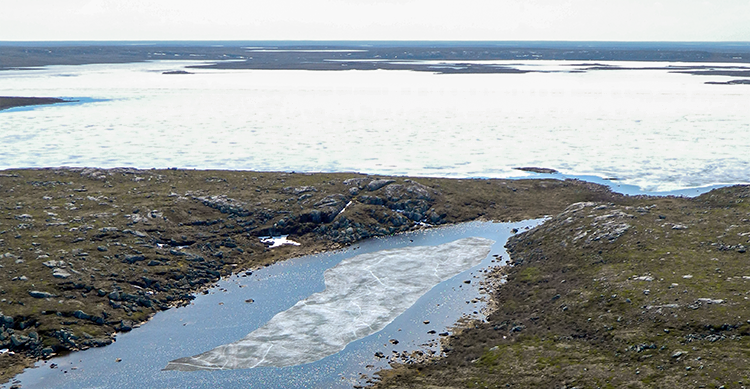
Climate is an important consideration in building new renewable energy projects in the north. (Photo: Valerie Miller)
Wind might be abundant in some northern territories, but wind farms are not simple to construct. Modern turbine blades, for instance, can span 40 to 90 meters and would likely have to be hauled in over dangerous and unpredictable ice roads, one at a time. Building a wind farm could require hundreds of trips across ice roads, each transit putting people at risk before construction could even begin.
Geothermal energy was attempted, but was likewise prohibitively expensive to set up, so it’s not employed in abundance. Solar is a separate question.
“Up to thirty percent of northern energy needs can be met by solar, but it has to be subsidized,” he says. With summers approaching twenty-four hour daylight in the far north, and near-total darkness in the winter, implementation of solar would depend dramatically on storage capability and grid integration, which is not currently an option.
Unfortunately, these technical limitations mean that most northern communities have one option for generating power locally: diesel generators. But even that is a high-cost proposition, because the fuel must be transported by barge, truck when ice roads are available, or flown in by plane. The cost per litre can be extraordinary –– and that cost has to be passed along to any customer using electricity generated by the fuel.
“It’s an expense that we might not even consider in the south of Canada, because we can rely on power lines,” Abhimanyu says. “There’s no connectivity, no grid they can connect to to draw power or even share excess power if they have it.”
Gridlock
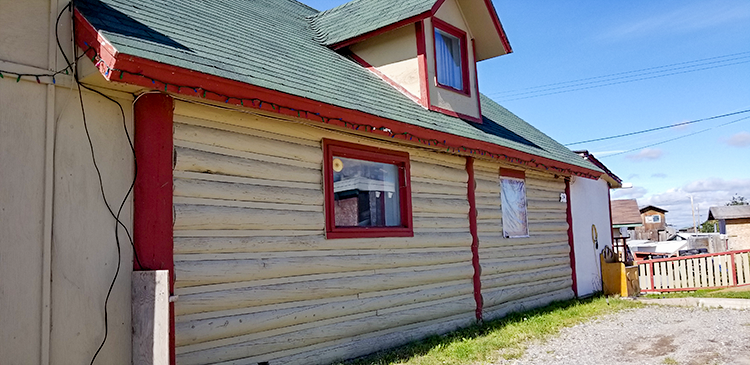
The cost of energy contributes inextricably to the problem of housing injustice in the north, including in the Tłı̨chǫ region. (Photo: Sandeep Agrawal)
The lack of grid interconnectivity serves as a major roadblock for the goal of achieving affordable energy throughout the NWT. In his research, Abhimanyu found that the total cost of connecting the NWT with the North American power grid is about $1.2 billion –– a sum that would be in addition to the annual $800 million that the Government of Canada provides to maintain current programs.
“Costs add up, and without the grid, they’d be relying on batteries to make power sources like solar work, which are so expensive. It makes it unviable,” Abhimanyu says.
In the near future, he believes the first step should involve improving the grid within the NWT. Improved intergrid connectivity, even between northern communities, would help pool costs and disseminate energy from the relatively metropolitan and accessible cities like Yellowknife to the surrounding communities, partly alleviating the need to ship diesel.
The territorial government is currently exploring ways to reduce the cost of energy. Their biggest initiative is an $800 million plan to connect existing hydroelectric projects –– the Taltson grid and Snare grid –– for better efficiency. That effort is making a dent in the $1.2 billion price-tag to achieve full integration, but it would take another $400 million to link to the nearby industry of diamond mines and achieve continental connectivity to Saskatchewan. In the meantime, the Government of NWT is also supporting an initiative promoting burning of wood pellets to heat homes.
“The territorial government is pushing, they own the Northwest Territories Power Corporation, and they’re trying to solve the issues,” Abhimanyu says. Non-governmental organizations are also helping, including Arctic Energy Alliance, which is building a number of small projects to support affordable energy.
Without funds to overhaul the current system however, finding options that systematically reduce the cost of energy –– and keep people in their homes –– is a challenge. Meanwhile, without change, more people –– and predominantly Indigenous people –– will continue to face the crisis of homelessness, owing in part to energy costs.
To move forward, the involvement of the federal government is required, but Abhimanyu and Sandeep are adamant that any real solution must have true, meaningful involvement from the most crucial stakeholders: the autonomous governments of the First Nations peoples themselves.
Finding a way forward
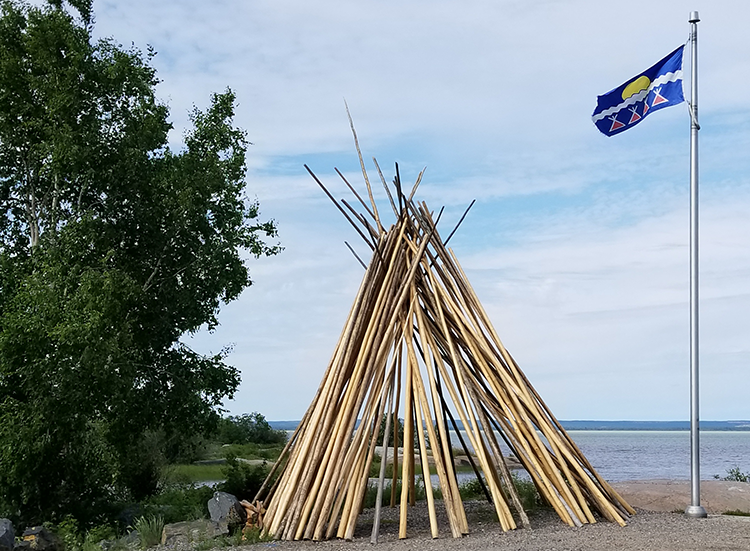
The Tłı̨chǫ Government flag flies in NWT. (Photo: Sandeep Agrawal)
Understanding human rights problems is complex, requiring the untangling of social, political, and economic factors alike. This is especially true in a place where a primarily Indigenous population is disproportionately suffering under a system that was imagined and implemented by those who came from a different place, tradition, and way of knowing.
“Indigenous communities bear the cost of something they weren’t really involved in designing,” Abhimanyu says. He believes that what Indigenous communities really need is more representation, involvement in the Canadian system, be it for energy production, distribution, or price setting measures. Only then, he has learned, will non-Indigenous people understand what the Indigenous people face and how their communities live.
In his opinion, listening to the Indigenous communities and allowing them to retain their dignity and determination is key: “People don’t just want financial assistance. And I’ve seen, back in India, that subsidies can push you back –– they reinforce the system that’s in place, even if that system doesn’t really solve the problems.”
This is in contrast to the current situation of homelessness in the north: the federal government pays the territorial government which manages public housing, with no involvement of the First Nations. This means that specific cultural issues may go unaccounted for.
Sandeep explains: “Non-Indigenous people often think of the Indigenous people as a monolithic culture. That’s not true.” Rather, he says, each culture is complex and encompasses the values and the worldview of multiple generations –– the elders as well as the new young generation.
Overlooking or ignoring that diversity means missing some of the social and cultural shifts being experienced in First Nations communities, including potential rifts between older and younger generations and differing opinions on the world. It also sets aside the continuing effects of Canada’s colonial past on Indigenous peoples.
“The solution for these problems is not just the physical aspects of housing such as new houses, new technologies,” Sandeep says. “This is about communities, their human rights, their Indigenous rights, and the ways in which we can help each other.”
For their part in that mission, the Agrawal group is working to share their findings with the public. Sandeep has published a report outlining practical recommendations to begin addressing issues of housing injustice in the north, but Sandeep points out that much more work remains to be done.
“Homelessness in the north is part of a complex web of factors,” he admits, “But if we start with energy, we might help alleviate some of the burdens, and push for progress.”
--------------------------------------------------------------------------------------------------------------
Sandeep, Abhimanyu, and Future Energy Systems thank the Tłı̨chǫ people and the Tłı̨chǫ Government for their gracious welcome and kind cooperation, without which this research would not be possible.
--------------------------------------------------------------------------------------------------------------
To learn more about this research, click here.
To discuss this work further, we welcome you to contact Sandeep at sagrawal@ualberta.ca, or to contact Abhimanyu at jamwal@ualberta.ca.